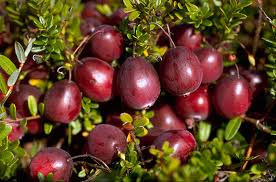
Cranberries are a unique fruit. They can grow and survive only under a very special combination of factors. These factors include acid peat soil, an adequate fresh water supply, and a growing season that extends from April to November. Cranberries grow on low-lying vines in beds layered with sand, peat, gravel and clay. These beds are commonly known as bogs or marshes and were originally created by glacial deposits. Commercial bogs use a system of wetlands, uplands, ditches, flumes, ponds and other water bodies that provide a natural habitat for a variety of plant and animal life.
The North American cranberry, Vaccinium macrocarpon, is the fruit recognized by the U.S. Department of Agriculture (USDA) as the standard for fresh cranberries and the cranberry juice cocktail. The European variety, which is grown in parts of central Europe, Finland and Germany, is known as Vaccinium oxycoccus. This variety is a smaller fruit with anthocyanin pigment profiles similar to that of the North American variety. The European variety, however, has a different acid profile in terms of the percentages of quinic, malic and citric acid levels present. In Europe, this fruit is commonly known as lingonberry or English mossberry.
Cultivation
The cranberry is a Native American wetland fruit which grows on trailing vines like a strawberry. The vines thrive on the special combination of soils and water properties found in wetlands. Wetlands are nature's sponges; they store and purify water and help to maintain the water table. Cranberries grow in beds layered with sand, peat and gravel. These beds are commonly known as bogs or marshes and were originally formed as a result of glacial deposits.
| Cranberries prefer sun with partial shade. Soil should be on the acidic side, moist but well drained. |
| |
 To plant, dig in ericaceous compost or leaf mould if your soil is not acidic. Space bushes 90cm/3ft apart on all sides mulch with a layer of acid peat or bark after planting if possible. Water in well. To plant, dig in ericaceous compost or leaf mould if your soil is not acidic. Space bushes 90cm/3ft apart on all sides mulch with a layer of acid peat or bark after planting if possible. Water in well.
If planting in a container a good size is 60cm/2ft wide x 60cm/2ft deep. Make sure there are plenty of drainage holes in the bottom of the container. Place a 2.5cm/1" layer of stones or crocks in the bottom and cover with enough soil or compost so that when you place the tree in the container, the original planting depth (which you should be able to see on the stem of the bush) 5cm/2" below the top of the container. Fill the container with soil or compost mixed with an ericaceous compost or leaf mould compost to within 5cm/2" of the top of the container. Firm well and water in.
|
Aftercare-
Every year in January apply a 5cm/2" acid peat or bark mulch to the surface of the soil surrounding the bush to a radius of 30cm/12" and apply an acid based fertiliser yearly in early March. Keep well watered though not sodden. If growing in a container, after the the first season of fruiting, it is best to carefully remove the top layer of compost and replace it with fresh compost every year in January. Do this very carefully so as not to damage the roots. Keep well watered though not sodden.
Remember to protect the plant from birds with netting. Once the fruit begin to swell, keep very well watered.
Harvesting
Takes place from September onwards but must be completed before any frosts. Once the berries turn deep red, pick individual berries as and when they ripen.
Cuttings
Cuttings can be taken in very early spring or in early July. Cut sections of stems 20cm/8" long, remove flower buds and/or most leaves only leaving the top 3 or 4 leaves if present, then insert the bottoms into pots containing a sandy compost. Place in a warm shaded place in a greenhouse, frame or propagator where they should root within 8 weeks. Gradually harden off before potting on into larger containers. Grow on for 1 year before planting in their permanent positions.
Pruning- Cranberry bushes require minimal pruning. In early spring prune out dead and damaged stems and any stem which you wish to shorten to keep the plant tidy.
|

No comments:
Post a Comment